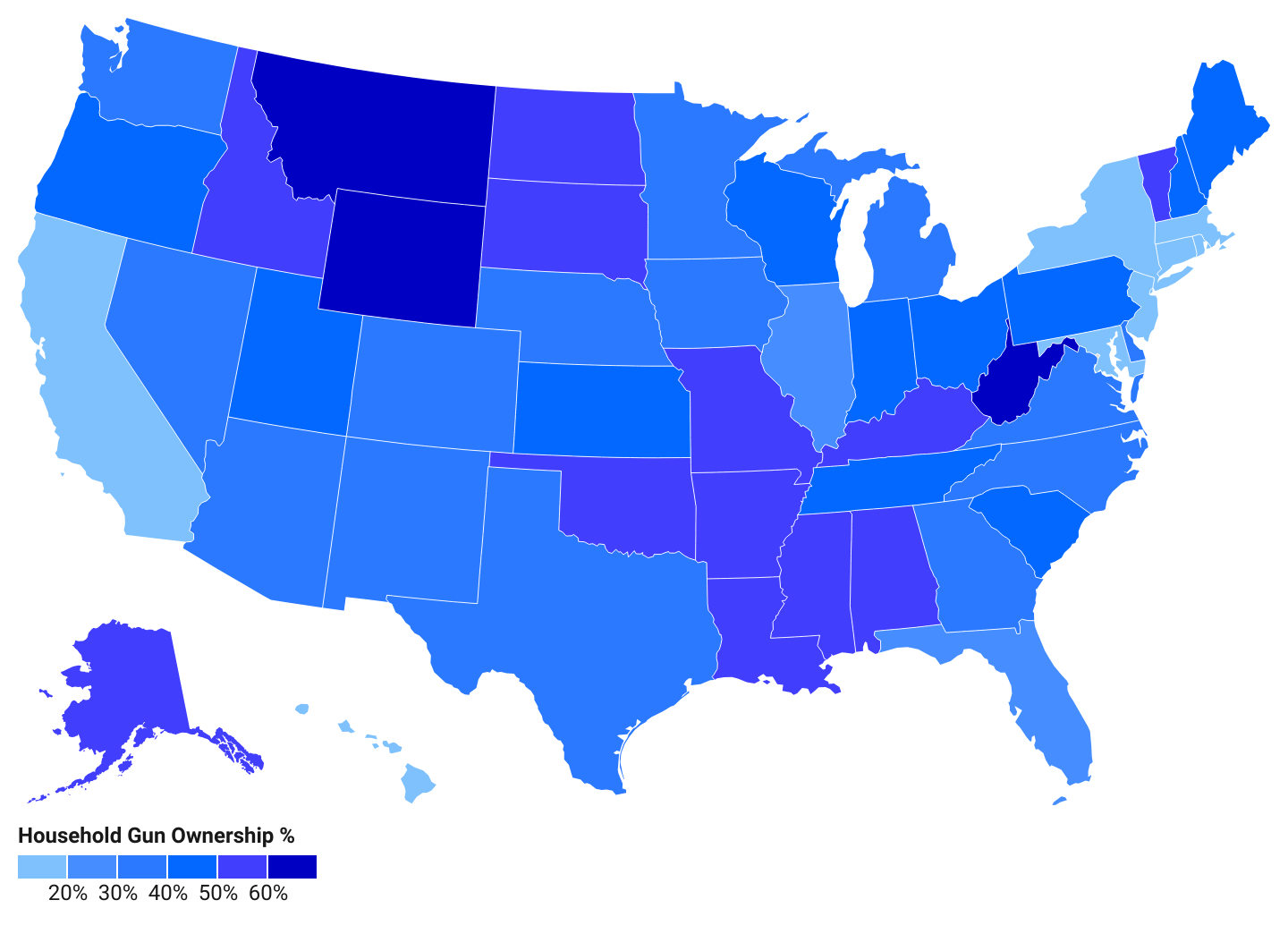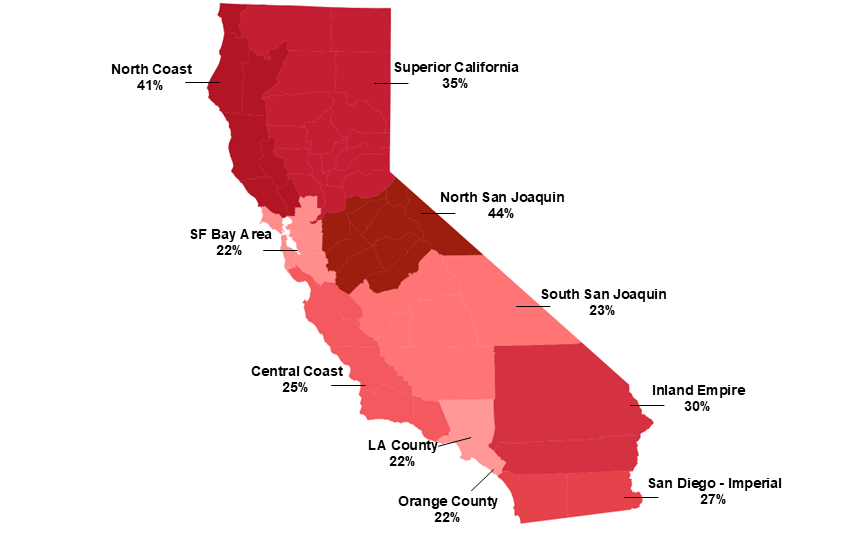Firearm Ownership
Firearm ownership in the United States is diverse and dynamic, with most people owning for self-protection
Firearm owners are a diverse group of people who own guns for various reasons, including protection, hunting, and sport shooting, and guns are often an important part of people’s identity and way of life.
Firearms are common in US households. Recent surveys estimate that 32% of US adults personally own firearms and that an additional 10% of adults live in households with firearms, but do not personally own them.1
Who Are Firearm Owners?
Throughout the 19th and 20th centuries and until about 2010, people in the US owned firearms primarily for hunting, target shooting, and collecting. Although some people still own firearms for these reasons, gun ownership has shifted toward ownership primarily for self-defense. This transition toward ownership for self-defense started with social and cultural unrest in the 1960s and 1970s, a trend that grew over subsequent decades.2 In 2023, only about 30% of firearm owners reported owning mainly for hunting or sport shooting and 15% for collecting.1
Historically and today, firearm ownership is higher among men (40%) than women (25%), non-Hispanic white adults (38%) than those of other races/ethnicities (10-24%), and older adults age 50 and over (35%) than younger adults under 30 (21%).1 More people in rural areas (47%) than in suburban (30%) or urban (20%) areas report that they own guns.1 Veterans are twice as likely as non-veterans (45% vs. 22%) to own firearms.3 Gun ownership is concentrated, with the majority of guns in the US (60%) owned by only 20% of owners.4
Starting in 2020, firearm ownership expanded rapidly among groups that historically had lower rates of ownership, coinciding with social unrest prompted by the COVID-19 pandemic and nationwide protests over racial injustice.2 An unprecedented 7.5 million people in the US became new owners between January 2019 and April 2021. These first-time owners were more likely to be female, non-Hispanic Black, Hispanic, younger, and live in households with children. New owners were also twice as likely (61%) as owners overall (30%) to own only handguns, affirming new owners’ focus on self-defense.5
Geographic Variation in Firearm Ownership
Household Firearm Ownership in the US, 2016

Firearm ownership in the US varies significantly by state and region. Rocky Mountain, Appalachian, and Southern states tend to have higher gun ownership rates, often exceeding 50% of households, while states in the Northeast generally have the lowest rates, with some below 20%.6
The states with the highest percentage of households with firearms are Montana (65%), Wyoming (61%), West Virginia (60%), Idaho (58%), and Alaska (57%). The states with the lowest household firearm ownership are New Jersey (9%), Massachusetts (9%), Hawaii (9%), and Rhode Island (14%).6
Household Firearm Ownership in California, 2024

Fewer Californians own a firearm than Americans overall (15%7 vs. 32%1). An additional 11% of Californians live in a household with someone who owns a firearm.7 Household gun ownership is higher in the North San Joaquin Valley (44%), the North Coast (41%), and Superior California (35%)—regions that have smaller populations and more rural areas. The lowest gun ownership is in the more densely populated and more urban and suburban San Francisco Bay Area, Los Angeles County, and Orange County, where 22% of households have firearms.7
Firearm Ownership and Safety
Many firearm owners demonstrate a strong commitment to safety, practicing responsible handling and storage, enforcing rules at the range, and emphasizing preparedness for threats or emergencies. For most, firearms are viewed as essential tools for personal protection and defense of their families and communities.8 Self-defense is the primary reason that 72% of Americans own firearms,1 up from 26% in 1999 and 48% in 2013.9 Additionally, most US adults (64%) believe that having a firearm in the home makes you safer, a percentage that has doubled since 2000.10
Despite intentions to enhance safety, research consistently shows that owning and carrying a firearm are associated with increased risk of injury and death – both for the firearm owner and those around them. A review of 16 studies found that people with access to firearms are three times more likely to die by suicide and twice as likely to be killed by someone else, compared to those without access.11
Recent research that followed millions of Californians over several years found that living with a handgun owner doubles the risk of dying by homicide12 and that handgun ownership more than triples the risk of suicide.13 In cases of intimate partner violence, victims are 11 times as likely to be killed if the abusive partner has direct access to a firearm.14 Additionally, communities with more permissive concealed carry laws experience higher rates of homicide, violent crimes, and police shootings of civilians.15
Recent evidence also shows that defensive gun use, defined broadly as using a firearm to defend oneself or others from a crime, is uncommon. A large, nationally-representative survey found that the vast majority of US adults with firearm access had never engaged in defensive gun use – including telling or showing someone you have a firearm or firing a gun in someone’s vicinity or at them – during their lifetime (92%) or in the past year (over 99%).16 In addition, there is little evidence that defensive gun use is uniquely beneficial for preventing injury or property loss.17
Owning a firearm is a personal choice and a constitutional right that comes with responsibilities. Firearm owners and clinicians should be aware of the risks and take steps to help prevent firearm-related harm. Formal firearm training for those with access to firearms is broadly supported; however, a nationwide survey of US adults found that only 61% of firearm owners and 14% of non-owners living with a firearm owner had received formal firearm training.18 In addition, firearm safety conversations and trainings typically focus on preventing unintentional injuries or defending against external threats.8 Firearm owners can also promote safety by learning how to keep themselves and others safe during crises, when the risk of suicide and violence are elevated.
- For most U.S. gun owners, protection is the main reason they own a gun.
- Gun culture 2.0: The evolution and contours of defensive gun ownership in America. The Annals of the American Academy of Political and Social Science.
- Firearm ownership among American veterans: findings from the 2015 National Firearm Survey. Injury Epidemiology.
- The Stock and Flow of U.S. Firearms: Results from the 2015 National Firearms Survey. The Russell Sage Foundation.
- Firearm Purchasing During the COVID-19 Pandemic: Results From the 2021 National Firearms Survey. Annals of Internal Medicine.
- State level estimates of household firearm ownership.
- Census region estimates of household firearm ownership in California. Unpublished data.
- Firearms training: what is actually taught? Injury Prevention.
- Perspectives of gun owners, non-owners: Why own a gun? Protection is now top reason.
- Guns. Gallup Historical Trends.
- The accessibility of firearms and risk for suicide and homicide victimization among household members: a systematic review and meta-analysis. Annals of Internal Medicine.
- Homicide deaths among adult cohabitants of handgun owners in California, 2004 to 2016 : A cohort study. Annals of Internal Medicine.
- Handgun ownership and suicide in California. New England Journal of Medicine.
- Risk Factors for Male Perpetration and Female Victimization of Intimate Partner Homicide: A Meta-Analysis. Trauma Violence Abuse.
- The effects of concealed-carry laws.
- Lifetime and past-year defensive gun use. JAMA Netork Open.
- The epidemiology of self-defense gun use: evidence from the National Crime Victimization Surveys 2007-2011. Preventive Medicine.
- Formal firearm training among adults in the USA: results of a national survey. Injury Prevention.